Chambers Still On Duty
by Charlie Allmon
Reprinted from "Crown Jewels of the Wire", July 1988, page 11
From the heartland of rural Missouri comes news and photographic proof of an
incredible insulator find. A find never previously reported in "Crown
Jewels," and one I hope will entertain all subscribers. In this article, we
will see photos taken recently of an unusually old farm barn still equipped with
an original Chambers Lightning Protection System.
On March27 of this year, Chris
Hedges and I met with an old friend and early insulator collector named Buck
Clevenger. We have known Buck for almost 20 years, since he is an electric
lineman, and was involved in the early collecting heyday in Kansas City. It was
during this period that some of our most beautiful and sought after insulators
were recovered from outdated power lines in the metropolitan area. Later, Buck
was transferred out of town and during this change of work territory, he lucked
out and discovered this old barn. Without Buck's discovery and assistance, this
story would not have been possible.
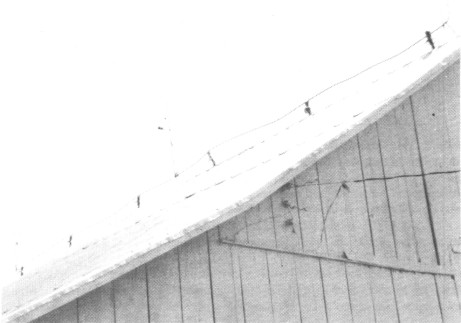
The picture above shows a view of the entire length of the Chambers system.
Mounted beneath the cable are six of the large CD 317 insulators. Also visible
are three vertical lightning rods, two remaining arrows, and one surviving CD
132.4 companion Chambers. It is obvious that the roofing material is not
original, but all replacement and improvement efforts have been made with the
intention of preserving the Chambers system.
The next picture shows two of the CD 317s, mounted at the end of the
system. Notice the unusual height of the air terminal, in relation to the three
footed lightning rod.
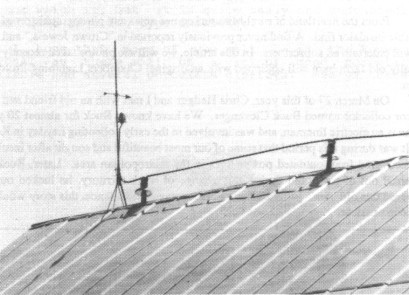
This picture is a close-up of the one above and gives a much better view of
the CD 132.4 support insulator.
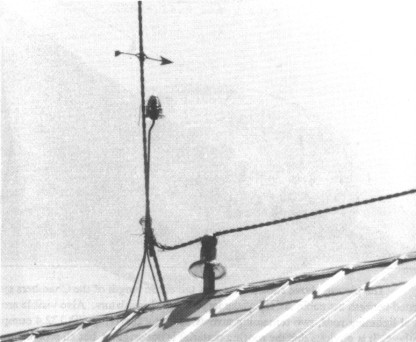
You can almost view the constructed groove of the
insulator's base. This groove was designed to provide structural support for the
massive air terminal. If you look closely, you can see the wire used to connect
the insulator to the air terminal. Also notice the ground cable trailing
downward, and disappearing beneath the barn roof. We made a careful search of
the back side of the barn, but turned up no evidence of any CD 124.5
"handle" Chambers. If these were ever installed, they simply did not
survive.
The next picture is a view of the middle rod located along the center
of the roof. Notice the hole in the tail of the arrow and the strange looking
"glob" directly above the roof cable.
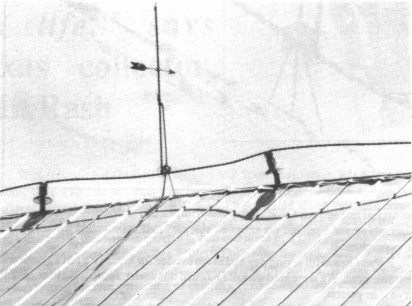
The final photograph (see next page) is a close up of the above picture. You
are now looking at an insulator collector's nightmare! You can easily see that
the base of the companion Chambers is all that remains. The insulator has been
broken, and the base has dropped down the rod and lodged near the top of the
three feet. When one compares this damage with the hole in the arrow tail, one
cannot help but ponder the possibility of a farm boy entertaining himself many
years ago with his 22 caliber rifle!
After photographing the barn, we
temporarily split up. Chris went into the farmhouse to interview the owners.
Buck and I stayed outside and visited with the neighborhood historian who
happened to drive by. Later we compared notes, but found the information gleaned
was sparse. No one could remember hearing talk of the barn's construction date,
nor the name of the farm's original owners. Consensus of opinion was the barn
was slightly over 100 years old. The carpentry characteristics seemed to confirm
this because we found that the floor and roof supports had been
"pegged" to the main beams with one inch wooden dowel rods, as opposed
to the use of metal bolts and nails. The owners also told us the barn had
originally been built with a hardwood floor.
It was interesting to note that no
one seemed to understand the historical significance of the Chambers system. The
owners seemed genuinely unaware of its collector appeal and antique value. Apparently, no one had previously shown
any interest in photographing the bar, and no antique "sharpie" had
approached the owners in an attempt to purchase it.

It was a beautiful spring
day and as we headed for home, we felt a genuine sense of accomplishment. We
were glad we had recorded this scene, and to have been privileged to observe it
in person.
For the sake of privacy and the protection of these antiques, we have
given the property owners our commitment to not publish their names or the
location of their property. But I wish to personally thank them for their
assistance in the preparation of this feature. Also -- a special thank you to Chris
Hedges for his photographic expertise. Mighty good job, buddy!
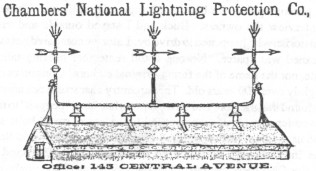
A 1882 Cincinnati Business Directory ad showing the Chambers System
| 